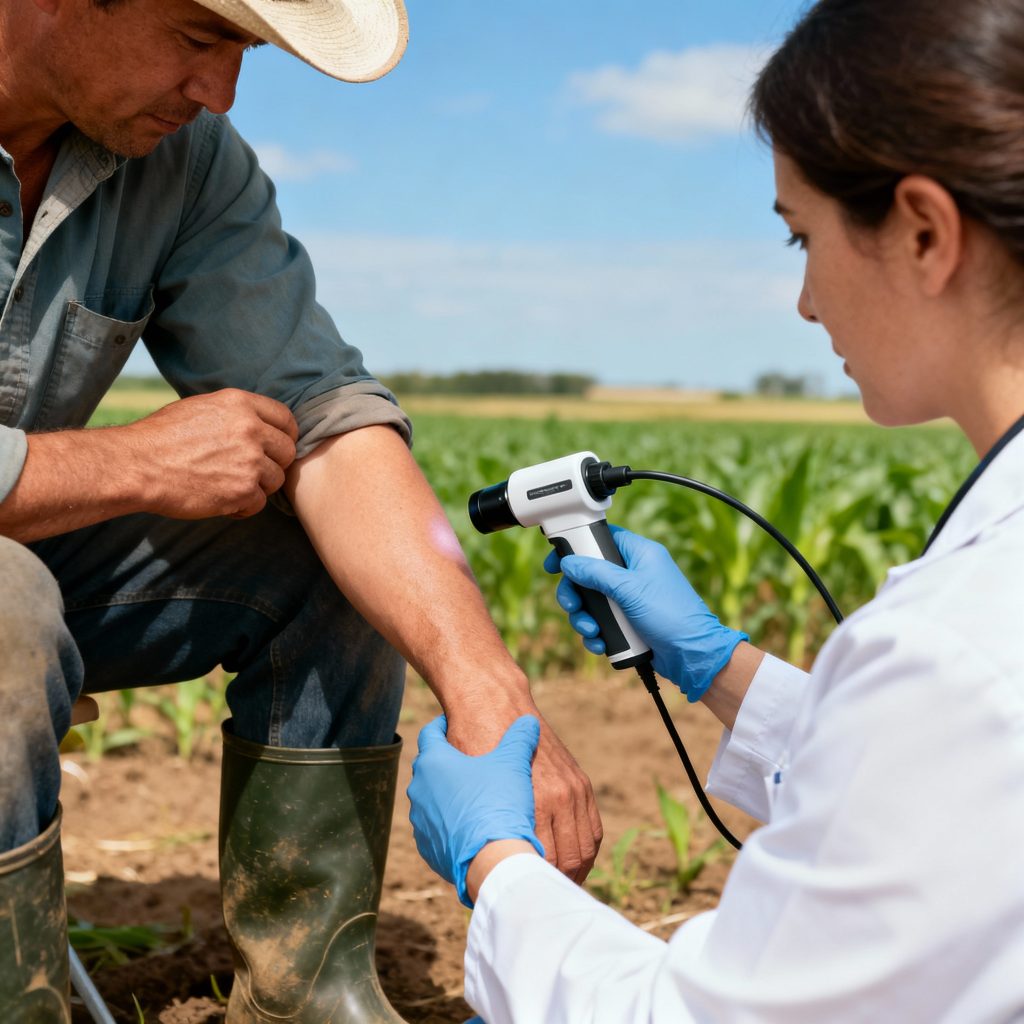Australia has some of the highest rates of skin cancer globally, with strong links between occupational UV exposure and skin cancer risk particularly melanoma and non-melanoma cancers. Every employer (PCBU) has a legal duty to create a safe workplace that reduces risks from harmful UV radiation. Regular onsite skin checks are a proven way to support this duty of care, detecting early signs of skin cancer, assessing sun damage, and encouraging sun safety at work.
High-risk outdoor professions include construction, mining, agriculture, logistics, transport, marine, utilities, and trades. However, any worker with significant sun exposure, including warehouse staff and drivers, can benefit from routine skin examinations. Sun protection and regular workplace melanoma screening form a vital part of a comprehensive workplace health strategy.

Audiometrics & Medical Personnel specialise in bringing health surveillance directly to your workplace. We work with businesses across NSW and Victoria to integrate skin cancer screening into their OHS programs. Our on-site service provides:

By partnering with Audiometrics, companies fulfil their duty of care and can demonstrate a proactive approach to occupational health. On-site screening makes it much more likely that busy employees will participate than requiring them to book separate appointments.
| Feature | On-site Workplace Skin Checks | Standard Clinic-Based Screening |
|---|---|---|
| Convenience | Conducted at your workplace—no travel; minimal downtime for staff. | Employees must schedule individual visits, taking time off work. |
| Participation | Group appointments encourage high uptake across all employees. | Lower turnout—some may skip due to inconvenience or cost. |
| Examination Detail | Full head-to-toe exam by a specialist nurse (including difficult areas). Dermatoscope used on every person. | Often limited exam or only targeted areas; dermatoscopy may not be standard. |
| Follow-up Coordination | Immediate referral advice provided on-site; follow-ups can be arranged through the program. | Employees must seek out their own follow-up if anything is found. |
| Custom Reporting | We deliver a company report summarising results and recommendations for your workplace. | Employees only get individual notes; no aggregate workplace feedback. |
| Compliance | Helps meet WHS requirements for workplace health checks and UV risk control. | No integration with company’s WHS program; risk controls rely on employee initiative. |
After screening your employees, we provide a comprehensive report tailored to your workplace. The report typically includes:
This custom report helps your safety team understand workforce risk factors and supports reporting to management or safety regulators. It also serves as a record of due diligence in protecting employee health.
Australian and state workplace safety regulations explicitly recognise UV exposure as a hazard that must be managed. For example:
– Work Health and Safety Act (WHS Act 2011) in NSW and the Occupational Health and Safety Act 2004 in Victoria both require employers to maintain a work environment “safe and without risks to health”. Employers must identify hazards (like UV radiation) and control them so far as is reasonably practicable.
– Safe Work Australia guidance highlights that “solar ultraviolet radiation (UVR) is the leading cause of skin cancer in Australia”. PCBUs must manage the risk of sun-related injury and disease, just as they would chemical or noise hazards.
– WorkSafe Victoria notes that outdoor workers are generally 5–10 times more exposed to UV than indoor workers. It recommends year-round sun protection (clothing, hats, sunscreen, shade) and requiring employers to implement UV risk controls.
– SafeWork NSW (via ARPANSA guidance) likewise advises that UV is a non-ionising radiation hazard which can cause skin cancer and that PCBUs have a duty of care to apply the hierarchy of controls.
By conducting regular workplace skin screenings, employers align with these guidelines and demonstrate compliance. This is often part of a broader sun-safety policy, which might include risk assessments, provision of PPE (wide-brim hats, sunscreen), and training on UV awareness.
Protect your team with professional on-site skin screening – it’s an easy, effective way to reduce skin cancer risk at work. Contact Audiometrics & Medical Personnel today to book a workplace skin check for your NSW or Victorian staff. Call 03 9819 4355 or [email protected] or for more information and to schedule a screening. Our friendly team will guide you through every step. Don’t wait – skin cancer can be treated successfully if caught early, and your employees’ health is too important to overlook.
Lorem ipsum dolor sit amet, consectetur adipiscing elit. Ut elit tellus, luctus nec ullamcorper mattis, pulvinar dapibus leo.

Audiometrics and Medical Personnel ATF The Trustee for KM Future Trust
03 9819 4355
Business Centre Entrance, C4, Level 1/2 Main St, Point Cook VIC 3030, Australia
30 A Verri Street, Griffith, NSW 2680